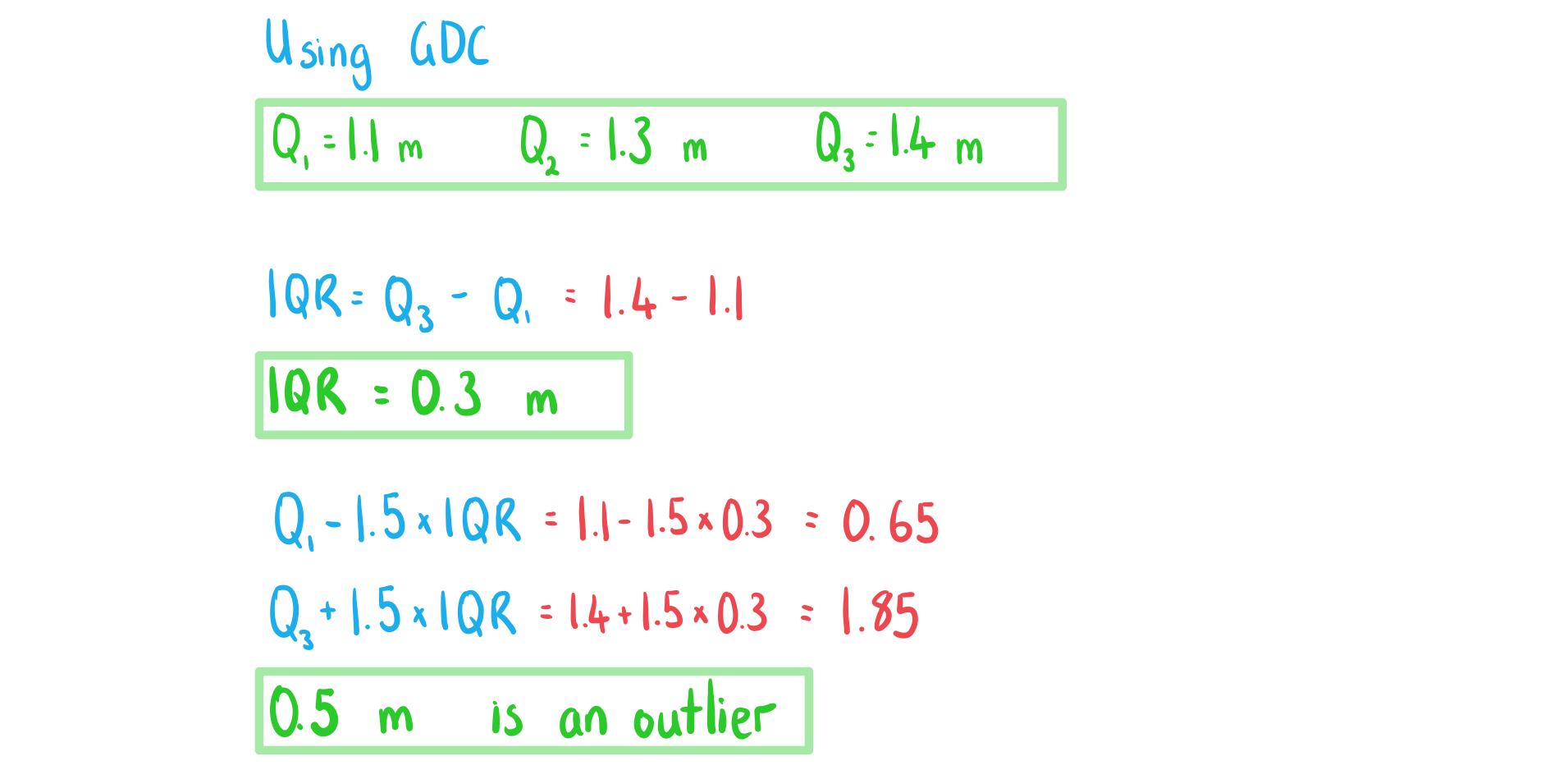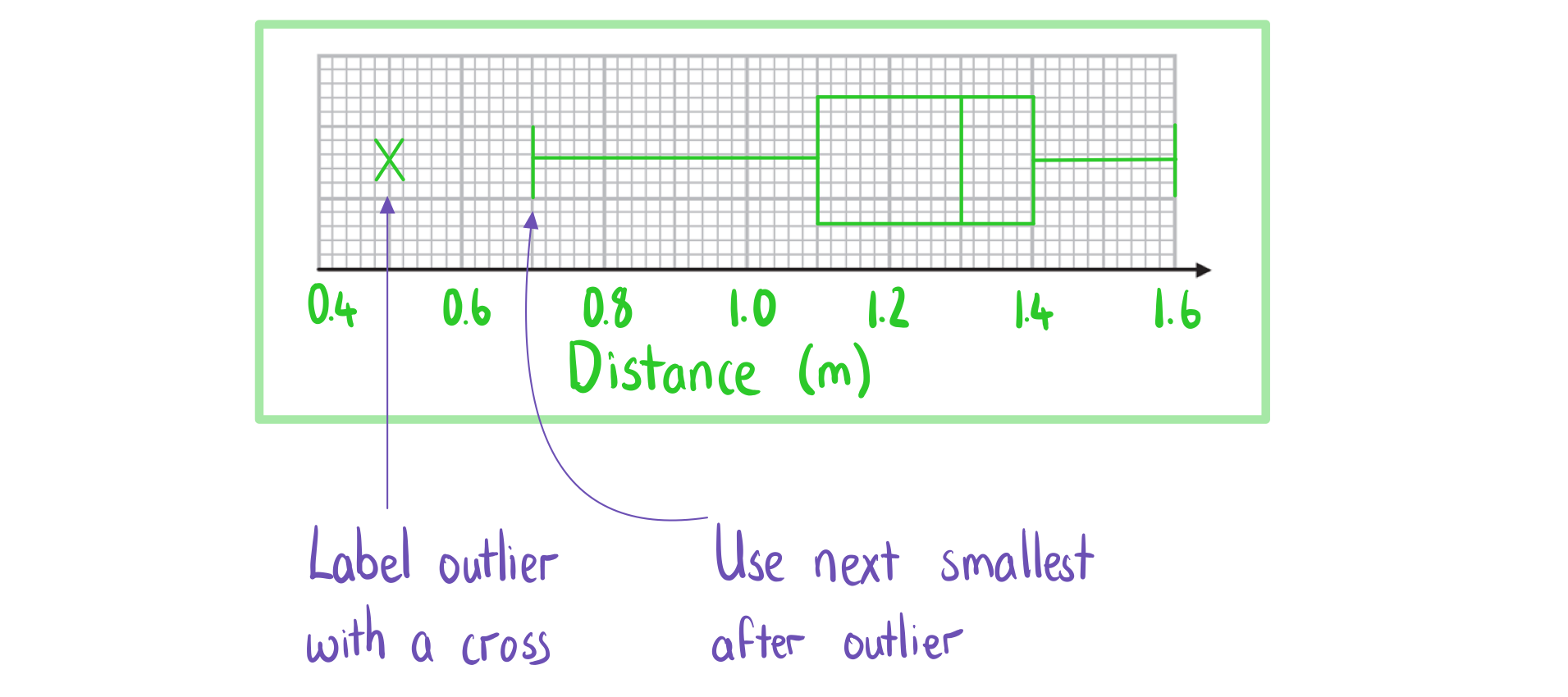Univariate Data (DP IB Applications & Interpretation (AI)) : Revision Note
Did this video help you?
Box Plots
Univariate data is data that is in one variable.
What is a box plot (box and whisker diagram)?
A box plot is a graph that clearly shows key statistics from a data set
It shows the median, quartiles, minimum and maximum values and outliers
It does not show any other individual data items
The middle 50% of the data will be represented by the box section of the graph and the lower and upper 25% of the data will be represented by each of the whiskers
Any outliers are represented with a cross on the outside of the whiskers
If there is an outlier then the whisker will end at the value before the outlier
Only one axis is used when graphing a box plot
It is still important to make sure the axis has a clear, even scale and is labelled with units

What are box plots useful for?
Box plots can clearly show the shape of the distribution
If a box plot is symmetrical about the median then the data could be normally distributed
Box plots are often used for comparing two sets of data
Two box plots will be drawn next to each other using the same axis
They are useful for comparing data because it is easy to see the main shape of the distribution of the data from a box plot
You can easily compare the medians and interquartile ranges
Examiner Tips and Tricks
In an exam you can use your GDC to draw a box plot if you have the raw data
You calculator's box plot can also include outliers so this is a good way to check
Worked Example
The distances, in metres, travelled by 15 snails in a one-minute period are recorded and shown below:
0.5, 0.7, 1.0, 1.1, 1.2, 1.2, 1.2, 1.3, 1.4, 1.4, 1.4, 1.4, 1.5, 1.5, 1.6
a) i) Find the values of and
.
ii) Find the interquartile range.
iii) Identify any outliers.

b) Draw a box plot for the data.

Did this video help you?
Cumulative Frequency Graphs
What is cumulative frequency?
The cumulative frequency of x is the running total of the frequencies for the values that are less than or equal to x
For grouped data you use the upper boundary of a class interval to find the cumulative frequency of that class
What is a cumulative frequency graph?
A cumulative frequency graph is used with data that has been organised into a grouped frequency table
Some coordinates are plotted
The x-coordinates are the upper boundaries of the class intervals
The y-coordinates are the cumulative frequencies of that class interval
The coordinates are then joined together by hand using a smooth increasing curve
What are cumulative frequency graphs useful for?
They can be used to estimate statistical measures
Draw a horizontal line from the y-axis to the curve
For the median: draw the line at 50% of the total frequency
For the lower quartile: draw the line at 25% of the total frequency
For the upper quartile: draw the line at 75% of the total frequency
For the pth percentile: draw the line at p% of the total frequency
Draw a vertical line down from the curve to the x-axis
This x-value is the relevant statistical measure
They can used to estimate the number of values that are bigger/small than a given value
Draw a vertical line from the given value on the x-axis to the curve
Draw a horizontal line from the curve to the y-axis
This value is an estimate for how many values are less than or equal to the given value
To estimate the number that is greater than the value subtract this number from the total frequency
They can be used to estimate the interquartile range
They can be used to construct a box plot for grouped data
Worked Example
The cumulative frequency graph below shows the lengths in cm, , of 30 puppies in a training group.

a) Given that the interval was used when collecting data, find the frequency of this class.

b) Use the graph to find an estimate for the interquartile range of the lengths.

c) Estimate the percentage of puppies with length more than 51 cm.

Did this video help you?
Histograms
What is a (frequency) histogram?
A frequency histogram clearly shows the frequency of class intervals
The classes will have equal class intervals
The frequency will be on the y-axis
The bar for a class interval will begin at the lower boundary and end at the upper boundary
A frequency histogram is similar to a bar chart
A bar chart is used for qualitative or discrete data and has gaps between the bars
A frequency histogram is used for continuous data and has no gaps between bars
What are (frequency) histograms useful for?
They show the modal class clearly
They show the shape of the distribution
It is important the class intervals are of equal width
They can show whether the variable can be modelled by a normal distribution
If the shape is symmetrical and bell-shaped
Worked Example
The table below and its corresponding histogram show the mass, in kg, of some new born bottlenose dolphins.
Mass, | Frequency |
4 | |
15 | |
19 | |
10 | |
6 |
a) Draw a frequency histogram to represent the data.

b) Write down the modal class.


You've read 0 of your 5 free revision notes this week
Unlock more, it's free!
Did this page help you?
